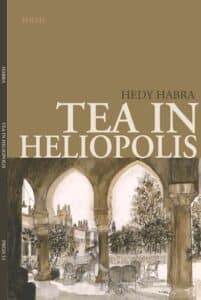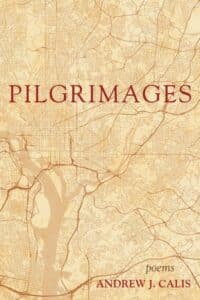Hedy Habra and Andrew Calis take you to a different place.
Last fall, I read new poetry collections by two poets I’d not encountered before – Hedy Habra and Andrew Calis. The poems of Habra’s Or Did You Ever See the Other Side? each begin with “or,” suggesting life’s alternatives and ambiguities. The poems by Calis in Which Seeds Will Grow? suggest hope can be found even in places and landscapes where it seems impossible.
I liked both collections so much I decided to find and read their first collections, Tea in Heliopolis: Poems (2013) by Habra and Pilgrimages: Poems (2020) by Calis.
In Habra’s first collection, she is very much the observer, sitting on a terrace or in a café (perhaps in Beirut, perhaps Alexandria). She watches the painting of a mural. At a friend’s house in Heliopolis, where she stops for tea, she sees the paintings on the wall, oils copying Impressionists; she watches the creation of a new painting and how the subject is arranged just so. As you read on, Habra is watching and recording — a sculpture, a bullfrog, in an underground house near the Pyramids, the poems taking on the color and feel of artwork. Even when she describes an open-air cinema, you sense you’ve walked into a painting.
And then she’s no longer describing a painting. She’s creating one.
A Glimpse of Fall

“Never paint a tree
in Spring or Summer,
paint them nude,
when you can see them
embrace each other,
when their antlered arms
raise in different directions.”
It’s too cold to paint
outdoors where the river
begins to melt under
ducks’ emerald green.
I’m glad the next-door
neighbors didn’t build.
Their tall crackled oaks
will be mine a while longer
still covered with
shriveled sandy-ochre leaves.
Leaves dry, cling
to their old birthplace.
I think of my mother
who always wanted
to be buried in Egypt
beside her husband, mother,
in their family vault.
Now, she’ll be buried
in the New World.
When I’d tell her,
“I’m taller than you
now,” she’d say,
“Don’t you know people
shrink with age? I wasn’t
always like this.”
I try to pull the crisp
auburn leaves, one by one.
They look old, dead,
but alive inside.
They won’t give up
until a new leaf
pushes them aside.

Hedy Habra
The poems of Tea in Heliopolis are like ekphrastic poems, but they are less inspired by artworks than they are creating artworks within the poems themselves. To read it is to feel the breeze from the Mediterranean and the sand from the desert.
Habra has published three other poetry collections: Under Brushstrokes, The Taste of the Earth, and Or Did You Ever See the Other Side? She’s also published a collection of short stories, Flying Carpets, and a book of literary criticism on the work of Peruvian writer and Nobel laureate Mario Vargas Llosa. In addition to a B.S. in pharmacy, she’s also earned M.A. and M.F.A. degrees in English and M.A. and Ph.D. degrees in Spanish literature. She’s received numerous awards and recognitions for her work, and she’s published multilingually in a wide array of literary journals and anthologies.
The poems of Calis’s Pilgrimages are more like psalms. Some are overtly religious; others take scenes and situations — a subway bombing, homelessness, a stifling office — and transform them into psalm-like poems. As in the Which Seeds Will Grow? poems, Calis speaks as a child of the Palestinian diaspora. While it’s less obvious in his first collection, it’s nonetheless there, underscoring almost every poem.
He excels at combining both connection and disconnection, and how they exist simultaneously. You experience this when you read about him describing a photograph on a wall, the tattoo he never got, breaking up a fight at school (he’s a teacher), attending a wedding, or rocking a baby to sleep. This is how he describes one of the lectures he attends:
In Words Already Dead: At Another Lecture

above the world for deep theology, Hegelian swirls
and history. He speaks of ages dead before his birth,
Earth-days that lord as distant God. So well he thinks
he knows, he winds in his own reasons.
But his words are born stone-still. They stir not even air,
withering as weed-pulled root, their smallness
unheard, crackling in summer’s heavy heat.
The room thirsts
for God’s large breath. We suffer —
clutching under words that long to live.

Andrew Calis
Calis is listening to the lecture, and hearing and understanding the words, but he knows that the words are becoming meaningless, even while the audience longs to embrace them.
His work has been featured in Dappled Things, The Atlantic, and several other literary publications. He has published two poetry collections, Pilgrimages in 2020 and Which Seeds Will Grow? in late 2024. He has a Ph.D. in English literature from the Catholic University of America. He’s a high school English teacher and lives with his family in Maryland.
I thoroughly enjoyed both first collections. They demonstrate the individual viewpoints poets bring to their subjects. Habra and Calis have individual perspectives, but both take you to a different place and make you see in a different light.
Photo by Fred Nassar, Creative Commons, via Unsplash. Post by Glynn Young.
How to Read a Poem uses images like the mouse, the hive, the switch (from the Billy Collins poem)—to guide readers into new ways of understanding poems. Anthology included.
“I require all our incoming poetry students—in the MFA I direct—to buy and read this book.”
—Jeanetta Calhoun Mish
- “Your Accent! You Can’t Be from New Orleans!” - October 9, 2025
- Poets and Poems: Donna Vorreyer and “Unrivered” - October 7, 2025
- Poet Sidney Lanier and the Lost Cause - October 2, 2025


Leave a Reply